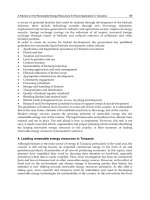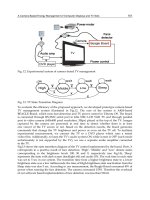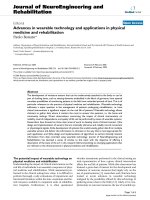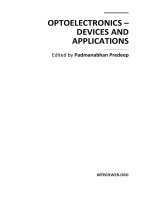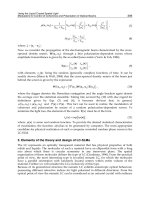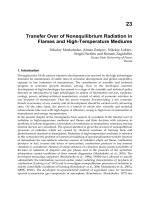New Perspectives in Biosensors Technology and Applications Part 9 pdf
Bạn đang xem bản rút gọn của tài liệu. Xem và tải ngay bản đầy đủ của tài liệu tại đây (7.52 MB, 30 trang )
New Perspectives in Biosensors Technology and Applications
232
capillary pressure (
Δ
P) inside the nanogap (shown in Fig. 4) with the sample solution of
water can be expressed as the following equation (Im, M. et al., 2007):
2
22
cos cos
SiO water
P
GL
γθ γθ
Δ= +
(1)
where
γ
is the liquid surface tension of the sample solution,
θ
SiO2
is the contact angle of
silicon dioxide,
θ
water
is the contact angle of water (full wetting), G is the width of the
nanogap, and L is the length of the nanogap, as shown in Fig. 3 and Fig. 4. For the sample
solution of water, capillary pressures estimated with Equation (1) are plotted in Fig. 5. In the
case of nanogap length of 1μm, the capillary pressure (
Δ
P) is about 3.38MPa.
Fig. 3. Schematic diagram showing notation of symbols used in calculations and
simulations.
2.2 Theoretical calculation of the nanogap filling depth
The sample solution continues to enter the nanogap if the capillary force is larger than the
pressure difference between the pressure inside the nanogap (P
x
) and the atmospheric
pressure (P
0
=0.1MPa). In the worst case where air cannot be evacuated from the nanogap,
the pressure inside the nanogap will be increased by compressed air and will have a
relationship delineated as follows:
x
H
H
PP
x
−
×=
0
(2)
where H is the height of the nanogap. Since the water meniscus will stop at the condition of
Δ
P=P
x
−
P
0
, we can calculate that the water meniscus can move to x=97nm of a 100-nm-deep
nanogap (H=100nm) even in the worst case, i.e. the nanogap is filled with compressed air.
Numerical Analysis and Simulation of Fluidics in
Nanogap-Embedded Separated Double-Gate Field Effect Transistor for Biosensor
233
This calculation result means that capillary pressure is sufficient to deliver the water to the
bottom surface of the nanogap. We will confirm this result with three-dimensional
simulations in the following section.
Fig. 4. A capillary force modeling of the nanogap highlighted by the dotted box in the SEM
image displaying AA‘ direction as shown in Fig. 3. G is the nanogap width, L is the nanogap
length, H is the nanogap height, x is the water penetration depth, P
0
is the atmospheric
pressure, P
x
is the pressure inside the nanogap, and
Δ
P is the pressure difference between P
x
and P
0
.
1 10 100 1000
0
20
40
60
80
100
Capillary Pressure,
Δ
P [MPa]
Nanogap Length, L [nm]
Fig. 5. A plot of capillary pressures as a function of the nanogap length, where G=30nm,
θ
SiO2
=45°,
θ
water
=0°, and
γ
=72.5mN/m for the sample solution of water.
New Perspectives in Biosensors Technology and Applications
234
3. Numerical simulations of the nanogap filling process
Although a study on the fluidics on a nanogap was previously carried out (Brinkmann et al.,
2006) to support earlier results with a nanogap biosensor (Haguet et al., 2004), only
theoretical calculations were presented. In order to visualize the nanogap filling and
support the calculation results provided in previous section, three-dimensional simulations
were also performed using CFD-ACE+
TM
(CFD Research Corporation, Huntsville, Alabama,
USA) with the structure shown in the inset of Fig. 3. CFD-ACE+
TM
is a commercial software
for multiphysics simulation, and has been used in previous microfluidic studies (Jen et al.,
2003; Kobayashi et al., 2004; Rawool et al., 2006; Rawool & Mitra, 2006; Yang et al., 2007; Im
et al., 2009).
3.1 Simulation setup
The finite element method is applied with structured grids, as shown in Fig. 6. In order to
observe the fluidic behaviour in nanogaps, fine meshes are used in the nanogaps, as
highlighted by the red dotted box in Fig. 6. On top of the nanogap-DGFET structure shown
in Fig. 3, 1.5-μm-high regions are additionally assigned for an initial water position
mimicking introduction of a water droplet on the nanogap-DGFET. The total number of
cells is 205,760 in 28 structured zones. Flow and Free Surfaces (VOF) modules are used in
this simulation. In the VOF module, the surface reconstruction method is chosen to be 2nd
Order (PLIC), and surface tension is considered. The wetting angle of the sidewall in the
nanogaps is assumed to be 45 deg due to the presence of native oxide. In addition to surface
tension, gravitational force is also considered along the Z-direction, as shown in Fig. 3. The
reference pressure of 100,000 N/m
2
(0.1 MPa) is set as the atmospheric pressure. Table 1
summarizes the physical properties of water used in this simulation study.
Fig. 6. Grid shapes for structured meshes for simulation. The dotted red box shows fine
meshes in the nanogap region.
Numerical Analysis and Simulation of Fluidics in
Nanogap-Embedded Separated Double-Gate Field Effect Transistor for Biosensor
235
Physical property Value Comment
Density (kg/m
3
) 1000 Constant
Viscosity (m
2
/s) 1×10
-6
Constant (Kinematic)
Surface tension (N/m) 0.0725 Constant
Table 1. Properties of water in the numerical simulation
Fig. 7. Nanogap filling of the sample solution of water at the nanogap edge indicated as AA’
in Fig. 5. At various instants of (a) 0 nsec (Initially, air is in the nanogap) (b) 95 nsec (c) 163
nsec (d) 315 nsec (e) 573 nsec (f) 643 nsec (g) 650 nsec (h) 681 nsec (Finally, the nanogap is
filled with the sample solution)
New Perspectives in Biosensors Technology and Applications
236
3.2 Simulation results: nanogap filling
Fig. 7 shows the water meniscus positions at various instants from the nanogap edge which
is denoted as AA’ in Fig. 3. Air inside the nanogap is continuously squeezed and
compressed by marching water along the sidewalls of the nanogap. Finally, the entire region
of the nanogap becomes filled with water, as confirmed in Fig. 7(h).
It is noteworthy that the wetting speeds are different at the centre and at the edge of the
nanogap in the simulation results. Positions of the water meniscus are plotted in Fig. 8; the
nanogap is completely filled with water within 700 nsec at the edge of the nanogap;
however, it takes longer than that at the centre of the nanogap.
From the calculation results in the previous section and the simulation results in this section,
we can find an interesting aspect of the fluidics in the nanogap. The length of the nanogap is
effectively reduced after some portion of the nanogap is wetted, because wetting occurs
from the edge of the nanogap. With a shorter nanogap, it is straightforward that the
capillary pressure becomes greater, as shown in Fig. 5. As a consequence, we can conclude
that the nanogap can be fully wetted with the sample solution by this sort of positive
feedback.
Fig. 8. Water meniscus positions as a function of time in the simulation structure shown in
the inset (L=1μm, W=250nm, H=100nm, and G=30nm). Hollow circles mean meniscus
positions at the nanogap edge and solid circles mean meniscus positions at the nanogap
centre.
The plateau in the graph of Fig. 8 is attributed to the pressure of the compressed air being
too high for the capillary pressure to overcome for further advancement. This phenomenon
is confirmed by monitoring pressure changes inside the nanogap together with
corresponding water meniscus positions. As shown by the dotted boxes in Fig. 9, the
pressure inside the nanogap increases gradually as the meniscus advances to the bottom of
the nanogap. In the process of nanogap filling, there is a period where only pressure
increment is observed without meaningful progress of the water meniscus locations.
Numerical Analysis and Simulation of Fluidics in
Nanogap-Embedded Separated Double-Gate Field Effect Transistor for Biosensor
237
Fig. 9. Water meniscus positions (shown in solid boxes) in the nanogap with corresponding
pressure changes (shown in dotted boxes).
New Perspectives in Biosensors Technology and Applications
238
3.3 Simulation results: expelling air bubbles from the nanogap
As shown in Fig. 9, air trapped inside the nanogap is pressurized by the capillary pressure
of water above the air. Then, where does the air finally go? By careful observation of the
simulation results, we can see air bubbles appear and disappear repeatedly inside the
nanogap, as shown in Fig. 10.
Fig. 10. Movement of water meniscus in the direction of BB’ shown in Fig. 5. (Closed-up
views near the B’ side) (a) 3.941 μsec (b) 4.310 μsec (c) 4.572 μsec (d) 4.625 μsec (e) 4.802 μsec
(f) 4.916 μsec (g) 4.964 μsec (h) 4.974 μsec. Air bubbles appears and disappears repeatedly to
lower the pressure of the air trapped inside the nanogap.
Numerical Analysis and Simulation of Fluidics in
Nanogap-Embedded Separated Double-Gate Field Effect Transistor for Biosensor
239
Because water continuously compresses the air in the nanogap with capillary pressure, it is
analyzed that a certain threshold pressure is necessary for the trapped air to evacuate an air
bubble against the capillary pressure. After the appearance of air bubbles, which occurs with
reduced pressure of the trapped air, the water meniscus proceeds further toward the
nanogap centre by additional compression of trapped air. Generated air bubbles from the
trapped air last for a period of a few tens of nanoseconds to three hundreds nanoseconds. By
repetition of this process (i.e. pressure reduction by air bubbles and further compression),
the nanogap is gradually filled with water.
From the simulation, the threshold pressure for generation of air bubbles is estimated to be
around 5MPa, which is 50 times the atmospheric pressure (0.1MPa). As shown in Figs. 9(f)
through 9(h), trapped air is eliminated after the pressure reaches roughly 5MPa. Air bubbles
cannot be seen in Fig. 9, because they will appear in different places, as shown in Fig. 10.
3.4 Simulation results: velocity vectors
The blue arrows in Fig. 11 represent velocity vectors of water and air in designated meshes.
These velocity vectors are obtained from the plane 5 nm away from the nanogap edge, as
shown in the figure. In the initial stage of nanogap filling, as shown in Fig. 11(a), air exits
quickly from the nanogap by advancing water. After velocity reduction of air, as seen in Fig.
11(b), the velocity direction of air changes toward the nanogap centre in the stage of
compressing air, as shown in Fig. 11(c). Finally, if some plane is filled with water, water will
fill the trapped air region at the nanogap centre, and consequently the velocity vectors are
oriented toward the centre of the nanogap, as shown in Fig. 11(d).
Fig. 12 shows velocity vectors when water cannot advance because compressed air resists
against the water. It is shown that the velocity vectors are oriented upward at the water/air
interface due to high pressure, represented by green colour in Fig. 12(b), which indicates
pressure of around 2MPa.
4. Conclusions
In this chapter, nanogap-DGFET’s fluidic characteristics are discussed with theoretical
calculations as well as numerical simulations. Theoretical computation based on appropriate
modelling predicts that almost complete filling of the nanogap with water is possible. Three-
dimensional simulations using CFD-ACE+TM support the theoretical calculations. Various
characteristics such as water meniscus position, pressure distribution, and velocity vectors
in the simulation results have been analyzed in detail for comprehensive understanding of
the process of nanogap filling in the nanogap-embedded biosensor. The sample solution of
water is expected to completely fill the nanogap by capillary pressure. These results indicate
that biomolecules in a water-based sample solution can be successfully delivered to sensing
regions (i.e. nanogaps) in nanogap-DGFET devices.
5. Acknowledgment
This work was supported in part by a National Research Foundation of Korea (NRF) grant
funded by the Korean Ministry of Education, Science and Technology (MEST) (No. 2010-
0018931), in part by the National Research and Development Program (NRDP, 2010-
0002108) for the development of biomedical function monitoring biosensors, which is also
New Perspectives in Biosensors Technology and Applications
240
(a) 191.8 nsec after beginning of
water penetration, air exits with
fast velocity from the nanogap by
capillary force of water from the
top. Velocity vectors of water are
toward the bottom of the
nanogap.
(b) 559.3 nsec after beginning of
water penetration, air still exits
with reduced velocity from the
nanogap. Water is being supplied
from the top of the nanogap.
(c) 600.0 nsec after beginning of
water penetration, the direction
of air velocity vectors is changed
toward the nanogap centre due to
additional capillary force from
the nanogap edge which is
completely filled with water. As
shown in Fig. 8, the nanogap
edges become wet before the
nanogap centre does.
(d) 738.7 nsec after beginning of
water penetration, water at the
lower part of nanogap moves to
the nanogap centre to fill the
remainder of the nanogap at this
region, as described in Fig. 10.
Fig. 11. Distribution of velocity vectors (shown as blue arrows) of air and water at 5 nm
away from a nanogap edge.
Numerical Analysis and Simulation of Fluidics in
Nanogap-Embedded Separated Double-Gate Field Effect Transistor for Biosensor
241
funded by the Korean Ministry of Education, Science and Technology. The work of M. Im
was supported in part by the Brain Korea 21 Project, the School of Information Technology,
KAIST, 2009. The authors would like to thank Mr. Jae-Hyuk Ahn, Dr. Jin-Woo Han, Dr. Tae
Jung Park, and Prof. Sang Yup Lee for their help in the fabrication and analysis of real
nanogap-DGFET devices in a previous study that motivated this work.
Fig. 12. Velocity vectors in the direction of BB’ shown in Fig. 5 with (a) water/air boundary
and (b) pressure distribution.
6. References
Bergveld, P. Development of an ion-sensitive solid-state device for neurophysiological
measurements. IEEE Transactions on Biomedical Engineering, Vol. BME-17, No. 1,
(January 1970), pp. 70-71, ISSN 0018-9294.
Bergveld, P. Thirty years of Isfetology what happend in the past 30 years and what may
happen in the next 30 years. Sensors and Actuators B : Chemical, Vol. 88, No. 1,
(January 2003), pp. 1-20, ISSN 0925-4005.
New Perspectives in Biosensors Technology and Applications
242
Brinkmann, M. ; Blossey, R. ; Marcon, L. ; Stiévenard, D. ; Dufrêne, Y. F. & Melnyk, O.
Fluidics of a Nanogap. Langmuir, Vol. 22, No. 23, (October 2006), pp. 9784–9788,
ISSN 0743-7463.
Cui, X. D. ; Primak, A. ; Zarate, X. ; Tomfohr, J. ; Sankey, O. F. ; Moor, A. L. ; Moore, T. A. ;
Gust, D. ; Harris, G. & Lindsay, S. M. Reproducible measurement of single-
molecule conductivity. Science, Vol. 294, No. 5542, (October 2001), pp. 571-574, ISSN
0036-8075.
Drummond, T. G. ; Hill, M. G. & Barton, J. K. Electrochemical DNA sensors. Nature
Biotechnology, Vol. 21, No. 10, (October 2003), pp. 1192-1199, ISSN 1087-0156.
Fritz, J. ; Baller, M. K. ; Lang, H. P. ; Rothuizen, H. ; Vettiger, P. ; Meyer, E. ; Güntherodt, H
J. ; Gerber, Ch. & Gimzewski, J. K. Translating biomolecular recognition into
nanomechanics. Science, Vol. 288, No. 5464, (April 2000), pp. 316-318, ISSN 0036-
8075.
Gu, B. ; Park, T. J. ; Ahn, J H. ; Huang, X J. ; Lee, S. Y. & Choi, Y K. Nanogap field-effect
transistor biosensors for electrical detection of avian influenza. Small, Vol. 5, No. 21,
(November 2009), pp. 2407-2412, ISSN 1613-6810.
Haguet, V. ; Martin, D. ; Marcon, L. ; Heim, T. ; Stiévenard, D. ; Olivier, C. ; El-Mahdi, O. &
Melnyk, O. Combined nanogap nanoparticles nanosensor for electrical detection of
biomolecular interactions between polypeptides. Applied Physics Letters, Vol. 84, No.
7, (February 2004), pp. 1213-1215, ISSN 0003-6951.
Im, H. ; Huang, X J. ; Gu, B. & Choi, Y K. A dielectric modulated field-effect transistor for
biosensing. Nature Nanotechnology, Vol. 2, (June 2007), pp. 430-434, ISSN 1748-3387.
Im, M. ; Cho, I J. ; Yun, K S. & Yoon, E. Electromagnetic actuation and microchannel
engineering of a polymer micropen array integrated with microchannels and
sample reservoirs for biological assay patterning. Applied Physics Letters, Vol. 91,
No. 12, (September 2007), 124101(3pp), ISSN 0003-6951.
Im, M. ; Im, H. ; Kim, D H. ; Lee, J H. ; Yoon, J B. & Choi, Y K. (2009). Analysis of a
superhydrophobic microlens array surface : as a microchannel wall for pressure
drop reduction, Proceedings of Thirtheenth Internation Conference on Miniaturized
Systems for Chemistry and Life Sciences (
μ
TAS2009), pp. 162-164, ISSN 1556-5904, Jeju,
South Korea, November 1-5, 2009.
Im, M. ; Ahn, J H. ; Han, J W. ; Park, T. J. ; Lee, S. Y. & Choi, Y K. Development of a
point-of-care testing platform with a nanogap-embedded separated double-gate
field effect transistor array and its readout system for detection of avian
influenza. IEEE Sensors Journal, Vol. 11, No. 2, (February 2011), pp. 351-360, ISSN
1530-437X.
Jen, C P. ; Wu, C Y. ; Lin, Y C. & Wu, C Y. Design and simulation of the micromixer with
chaotic advection in twisted microchannels. Lab on a chip, Vol. 3, (April 2003), pp.
77-81, ISSN 1473-0197.
Kim, D S. ; Park, J E. ; Shin, J K. ; Kim, P.K. ; Lim, G. & Shoji, S. An extended gate FET-
based biosensor integrated with a Si microfluidic channel for detection of protein
complexes. Sensors and Actuators B: Chemical, Vol. 117, No. 2, (October 2006), pp.
488–494, ISSN 0925-4005.
Numerical Analysis and Simulation of Fluidics in
Nanogap-Embedded Separated Double-Gate Field Effect Transistor for Biosensor
243
Kobayashi, I. ; Mukataka, S. & Nakajima, M. CFD simulation and analysis of emulsion
droplet formation from straight-through microchannels. Langmuir, Vol. 20, No. 22,
(September 2004), pp. 9868-9877, ISSN 0743-7463.
Kost, G. J. ; Ehrmeyer, S. S. ; Chernow, B. ; Winkelman, J. W. ; Zaloga, G. P. ; Dellinger, R. P.
& Shirey, T. The laboratory-clinical interface : point-of-care testing. Chest, Vol. 115,
No. 4, (April 1999), pp. 1140-1154, ISSN 0012-3692.
Oh, S. W. ; Moon, J. D. ; Lim, H. J. ; Park, S. Y. ; Kim, T. ; Park, J. B. ; Han, M. H. ; Snyder,
M. & Choi, E. Y. Calixarene derivative as a tool for highly sensitive detection and
oriented immobilization of proteins in a microarray format through noncovalent
molecular interaction. The FASEB Journal, Vol. 19, No. 10, (August 2005), pp. 1335-
1337, ISSN 0892-6638.
Patolsky, F. ; Timko, B. P. ; Zheng, G. & Lieber, C. M. Nanowire-based nanoelectronic
devices in the life sciences. MRS Bulletin, Vol. 32, No. 2, (February 2007), pp. 142-
149, ISSN 0883-7694.
Rawool, A. S. ; Mitra, S. K. & Kandlikar, S. G. Numerical simulation of flow through
microchannels with designed roughness. Microfluidics and Nanofluidics, Vol. 2, No.
3, (February 2006), pp. 215-221, ISSN 1613-4982.
Rawool, A. S. & Mitra, S. K. Numerical simulation of electroosmotic effect in serpentine
channels. Microfluidics and Nanofluidics, Vol. 2, No. 3, (February 2006), pp. 261-269,
ISSN 1613-4982.
Reed, M. A. ; Zhou, C. ; Muller, C. J. ; Burgin, T. P. & Tour, J. M. Conductance of a
molecular junction. Science, Vol. 278, No. 5336, (October 1997), pp. 252-254, ISSN
0036-8075.
Sakata, T. & Miyahara, Y. Direct transduction of allele-specific primer extension into
electrical signal using genetic field effect transistor. Biosensors and Bioelectronics, Vol.
22, No. 7, (February 2007), pp. 1311–1316, ISSN 0956-5663.
Schöning, M. J. & Poghossian, A. Recent advances in biologically sensitive field-effect
transistors (BioFETs). Analyst, Vol. 127, No. 9, (August 2002), pp. 1137–1151, ISSN
0003-2654.
Siu, W. M. & Cobbold, R. S. C. Basic properties of the Electrolyte-SiO2-Si system: physical
and theoretical aspects. IEEE Transactions on Electron Devices, Vol. ED-26, No. 11,
(November 1979), pp. 1805–1815, ISSN 0018-9383.
Stern, E. ; Wagner, R. ; Sigworth, F. J. ; Breaker, R. ; Fahmy, T. M. & Reed, M. A. Importance
of the debye screening length on nanowire field effect transistor sensors. Nano
Letters, Vol. 7, No. 11, (October 2007), pp. 3405–3409, ISSN 1530-6984.
St-Louis, P. Status of point-of-care testing : promise, realities, and possibilities. Clinical
Biochemistry, Vol. 33, No. 6, (August 2000), pp. 427-440, ISSN 0009-9120.
Tierney, M. J. ; Tamada, J. A. ; Potts, R. O. ; Eastman, R. C. ; Pitzer, K. ; Ackerman, N. R. &
Fermi, S. J. The GlucoWatch biographer : a frequent automatic and noninvasive
glucose monitor. Annals of Medicine, Vol. 32, No. 9, (December 2000), pp. 632-641,
ISSN 0785-3890.
Yang, C K. ; Chang, J S. ; Chao, S. D. & Wu, K C. Two dimensional simulation on
immunoassay for a biosensor with applying electrothermal effect. Applied Physics
Letters, Vol. 91, No. 11, (September 2007), 113904 (3pp), ISSN 0003-6951.
New Perspectives in Biosensors Technology and Applications
244
Yang, Y. T. ; Callegari, C. ; Feng, X. L. ; Ekinci, K. L. & Roukes, M. L. Zeptogram-scale
nanomechanical mass sensing. Nano Letters, Vol. 6, No. 4, (April 2006), pp. 583-586,
ISSN 1530-6984.
Yi, M. ; Jeong, K H. & Lee, L. P. Theoretical and experimental study towards a nanogap
dielectric biosensor. Biosensors and Bioelectronics, Vol. 20, No. 7, (January 2005), pp.
1320-1326, ISSN 0956-5663.
12
Fabrication of Biosensors Using
Vinyl Polymer-grafted Carbon Nanotubes
Seong-Ho Choi, Da-Jung Chung and Hai-Doo Kwen
Department of Chemistry, Hannam University, Daejeon 305-811,
Republic of Korea
1. Introduction
A biosensor is commonly defined as a device incorporating a bioreceptor connected to a
transducer, which converts an observed response into a measurable signal proportional to
analyte concentration which then is conveyed to a detector (Eggins, 1996). As demonstrated
in Fig. 1, a biosensor consists of a bio-element and a sensor-element. A specific bio-element,
including enzyme, antibody, microorganism, cell, and DNA, recognizes a specific analyte,
and a sensor element transduces the change in the biomolecules into an electrical signal.
Biosensors can be classified either by their bioreceptor or their transducer. Biosensors are
known as enzymatic biosensors (enzymes), genosensors (DNAs), immunosensors
(antibodies), etc. depending on the bioreceptors used. Biosensors can also be divided into
several categories based on the transduction process, such as electrochemical, optical,
piezoelectric, and thermal/calorimetric. Among these, electrochemical biosensors are the
most widespread, numerous and successfully commercialized devices of biomolecular
electronics (Dzyadevych et al., 2008).
Much literature on carbon nanotube (CNT)-based biosensors has been published over the
past several years because CNTs have the following advantages: (1) small size with large
surface area, (2) high sensitivity, (3) fast response time, (4) enhanced electron transfer and
(5) easy protein immobilization on CNT-modified electrodes, coupled with the fact that
several methods have been developed (J. Wang & Musameh, 2003a; J. Wang et al., 2003b; Y.
Saito et al., 1993). These properties make CNTs ideal for use in electrochemical biosensors
and nanoscale electronic devices. Such potential applications would greatly benefit from
CNTs in promoting the electron-transfer reaction of biomolecules, including catecholamine
neurotransmitters (J. Wang et al., 2002a), cytochrome c (J. Wang et al., 2002b), ascorbic acid
(Z. H. Wang et al., 2002), NADH (Musameh et al., 2002), and hydrazine compounds (Zhao et
al., 2002). The insolubility of CNTs in most solvents is a major barrier for developing such
CNT-based biosensing devices. Therefore, surface modification is necessary for CNT
materials to be biocompatible and to improve solubility in common solvents and selective
binding capability to biotargets.
There are two main approaches for surface modification of CNTs: a non-covalent wrapping
or adsorption and covalent chemical tethering. The non-covalent approach includes
surfactant modification, polymer wrapping, and polymer absorption via various adsorption
forces, such as van der Waals and π-stacking interactions. The advantage of non-covalent
modification is that the structures and mechanical properties of CNTs remain intact.
New Perspectives in Biosensors Technology and Applications
246
However, the force between the CNTs and the wrapping molecules is very weak, which
means that the load may not be transferred efficiently from the polymer matrix to the CNT
filler (Islam et al., 2003). The covalent functionalization of CNT surfaces can improve the
efficiency of load transfer from matrix to nanotubes. However, it must be noted that the
process to obtain functional groups may introduce defects on the walls of nanotubes. These
defects will lower the strength of the reinforcing component. Therefore, there will be a
trade-off between the strength of the interface and the strength of the CNT filler (Eitan et al.,
2003). The covalent functionalization of CNTs is most frequently initiated by introducing
carboxylic acid groups using nitric acid oxidation (Men et al., 2008; J. Shen et al., 2007;
Kitano et al., 2007). Thereafter, small molecules (Kooi et al., 2002; Liu, 2005; Tasis et al., 2003)
or polymer chains (Kang & Taton., 2003; O. K. Kim et al., 2003) can be chemically attached to
the CNTs by esterification and amidation reactions via the carboxylic acid moieties. The
chemical modification is an especially attractive target, as it can improve solubility (Bahr et
al., 2001) and processing ability and allows the unique properties of CNTs to be coupled to
other types of materials.
molecularly recognizing materials
Enzyme
Antibody
Microorganism
Cell
DNA,
signal transducer
Electric
signal
electroactive
substance
electrode
pH change
semiconductor
pH electrode
heat thermistor
light photon counter
mass change
piezoelectro
device
Fig. 1. Schematic diagram for the principal of the biosensors.
Radiation-induced graft polymerization (RIGP) is a useful method for the introduction of
functional groups into polymer matrices using specially selected vinyl monomers. There
have been several reports on RIGP of polar monomers onto the surface of polymer
substrates with hydrophobic properties to obtain hydrophilic properties for versatile
applications (Choi & Nho, 1999a, 1999b; Choi et al., 1999, 2000a 2000b, 2001; S. K. Kim et al.,
2010). RIGP can be easily modified for the surface of CNTs to induce free radicals on the
surface of nanotubes in aqueous solution and organic solvents at room temperature. Figure
2 shows the introduction of functional groups, such as hydroxyl, carboxyl, and sulfonic acid
onto the CNT surface (Oh et al., 2006a) and fullerene (Chung et al., 2011) using free radicals
generated during γ-ray irradiation.
In this chapter, we describe the fabrication of biosensors using vinyl polymer-grafted carbon
nanotubes prepared by RIGP. Various vinyl monomers used for functionalization of CNTs
will be introduced. The obtained vinyl polymer-grafted CNTs are used as biosensor
supporting materials to increase sensitivity and affinity for biomolecules. The
characterization and application of the four biosensor types are: (1) Enzyme-free biosensors
Fabrication of Biosensors Using Vinyl Polymer-grafted Carbon Nanotubes
247
based on chemical reaction, (2) Enzymatic biosensors based on functional group-MWNTs,
(3) Bacterial biosensors based on polymer grafted MWNTs, and (4) E-DNA biosensors based
on polymer grafted MWNTs, as summarized in Fig. 3.
Fig. 2. Radiolytic functionalization possible mechanism of Fullerene (C60) in H
2
O/MeOH
mixture solution.
Fig. 3. Schemetic fabrication of biosensor based on vinyl polymer-grafted MWNT.
New Perspectives in Biosensors Technology and Applications
248
2. Enzyme-free biosensor based on chemical reaction
Numerous methods based on enzyme immobilization for human cholesterol assays have
been developed, including colorimetric, spectrometric and electrochemical methods
(Crumbliss et al., 1993; Shumyantseva et al., 2004). The use of enzymes in the fabrication of
sensors has advantages due to their rapid, selective, and sensitive nature. However, there
exist some practical problems related to the use of enzymes in analytical devices due to their
short lifetime and low reusability since they are easily affected by temperature, humidity,
and pH (Gavalas & Chaniotakis, 2000, 2001). To address these issues, non-enzymatic sensors
based on the direct electrocatalytic oxidation of glucose are being investigated for their
stability, simple fabrication, reproducibility, low cost, and freedom from oxygen limitation,
unlike enzyme-based sensors (Lee et al., 2009). In this section, we discuss the preparation
and characterization of enzyme-free biosensors based on boronic acid-modified and metallic
nanoparticles-immobilized CNTs.
2.1 Chemical reaction between boronic acid containing group modified carbon
surface and target molecules
Boronic acids (-B(OH)
2
) can interact with cyanides (Badugu et al., 2004a) and fluorides
(Cesare & Lakowicz, 2002a), which have been explored for sensor development. Boronic
acids binding with diols (J. Wang et al., 2005) have been mostly studied in developing
fluorescent carbohydrate sensors. Boronic acids act as an electron withdrawing group in its
neutral form, -B(OH)
2
, and as an electron donation group in its anionic form, -B(OH)
3
-
.
Fig. 4. Preparation of non-enzymatic biosensor based on chemical reaction by RIGP.
The feasibility of tear glucose sensing was tested using a daily disposable contact lens
embedded with boronic acid-containing fluorophores which act as a potential alternative to
current invasive glucose monitoring techniques (Badugu et al., 2004b). The boronic acid
Fabrication of Biosensors Using Vinyl Polymer-grafted Carbon Nanotubes
249
probes in the contact lens could continuously monitor the tear glucose levels in the range of
50-500 µM. The boronic acid group showed higher affinity for D-fructose and smaller
affinity for D-glucose (Cesare & Lakowicz, 2002a). This means that the use of the boronic
acid group for sensing sugars is strongly dependent on the molecular geometry and the
aromatic species where boronic acid is present.
Poly(VBAc)-grafted MWNTs are of great interest for the preparation of enzyme-free sensors
because of the boronic acid group they contain. 4-Vinylphenyl boronic acid (VPBA) was
used to functionalize the surface of multi-walled carbon nanotubes (MWNTs) since it
possesses both hydrophobic and hydrophilic properties (D. S. Yang et al., 2010). The vinyl
group of the monomer attaches to the surface of MWNTs because of a hydrophobic-
hydrophobic interaction, while the functional group of the monomer comes to the surface in
an aqueous solution because of a hydrophilic-hydrophilic interaction. When irradiated, the
radical polymerization of the monomer on the surface of MWNTs occurs to form grafted
vinyl polymer PVBAc-g-MWNTs. Boronic acid in PVBAc-g-MWNTs couples with diols of
glucose to form a boronic acid diester group, as shown in Figure 4 (D. S. Yang et al., 2010).
The boronic acid content of PVBAc-g-MWNTs was 296 mg/g, as determined by titration.
The diols are linked covalently and the reaction is fast and completely reversible (Cesare &
Lakowicz, 2002b). The cyclic voltammograms of PVBAc-g-MWNTs in 0.1 M phosphoric
buffer solution displayed an excellent linear response to glucose concentration in the range
1.0–10 mM.
2.2 Catalytic reaction of the target molecules on the surface of metallic nanoparticle-
modified MWNT
Recently, an enzyme-free hydrogen peroxide (H
2
O
2
) biosensor was developed based on
nano-conducting polymer composites (MWNT–PEDOT nanoparticles) (K. C. Lin et al.,
2010). The use of enzyme-free H
2
O
2
biosensors is important in chemical, food and
environmental applications. More enzyme-free H
2
O
2
biosensors have been developed based
on modified carbon fiber microelectrodes (Y. Wang et al., 1998), vanadium-doped zirconias
(Domenecha & Alarcon, 2002) and Fe
3
O
4
(M. S. Lin & Leu, 2005).
Nanoscale materials of metal (Ag, Au, Pd, Pt, etc.), alloy (Pt-Ru), carbon and polymers are
very attractive for a variety of applications including optical and electronic nanodevices,
and chemical and biological nanosensors. Nanoparticles offer higher catalytic efficiency than
bulk materials due to their large surface-to-volume ratio (Yu et al., 1999; S. J. Kim et al.,
2008).
Initial research developing non-enzymatic sensors focused on the use of nanocrystalline
metals, such as Pt and Au, especially Pt-based amperometric electrodes (S. J. Park et al.,
2003; Song et al., 2005). However, such Pt-based glucose sensors lacked sufficient selectivity
and sensitivity due to chemisorbed intermediates and electroactive species. The desire for
better and cheaper electrocatalysts has resulted in bimetallic systems being developed. Pt-
Au (Habrioux et al., 2007; H. Liu et al., 1992), Pt-Pb (Cui et al., 2007; Bai et al., 2008; J. Wang
et al., 2008; Sun et al., 2001), and Pt-Ru (Xiao et al., 2009) have all displayed high
electrocatalytic activity for glucose oxidation.
Effective fabrication of electrocatalysts also depends on the support material (Hsu et al.,
2008). Catalyst dispersion and utilization have been shown to improve supporting Pt-Ru
nanoparticles on high-surface area carbon materials, such as CNTs, carbon nanofibers,
carbon nanocoils and carbon nanohorns (Steigerwalt et al., 2002; Hyeon et al., 2003; K. Park
New Perspectives in Biosensors Technology and Applications
250
et al., 2004; R. Yang et al., 2005). A systematic study has shown that MWNTs are the best of
the carbon based electrocatalyst supports (Reddy & Ramaprabhu, 2007). In principle,
MWNTs are seamless cylinders. However, they often have defects where the attachment of
Pt-based alloy nanoparticles most likely occurs.
In a preliminary report, Pt-Ru nanoparticles were deposited on the surfaces of various
carbon supports, including Vulcan XC-71, Ketjen-300, Ketjen-600, single-walled carbon
nanotubes (SWNTs), and MWNTs for use as fuel cell catalysts using γ-ray irradiation
without anchoring agents (Choi et al., 2003a, 2003b; Oh et al., 2006; Hwang et al., 2008). The
metal (Ag or Pd) and alloy (Pt-Ru) nanoparticles were also deposited on the surfaces of
SWNTs (Oh et al., 2005, 2006a, 2006b, 2008) and porous carbon supports using γ-irradiation
without anchoring agents (Seo et al., 2008). However, metallic alloy nanoparticles
aggregated on the surfaces of the carbon supports due to their hydrophobic nature. This
aggregation was overcome by modifying the surface of the carbon support to give it
hydrophilic properties. This was done by in-situ polymerization of β-caprolactone,
methacrylate and pyrrole using oxidizing agents as initiators (Bae et al., 2010). The polymer-
stabilized bimetallic (Pd-Ag) nanoparticles were prepared by γ-irradiation in organic
solvents and used as catalysts for hydrogenation of cis,cis-1,3-cyclooctadiene (Choi et al.,
2005). Pt- Ru nanoparticles were then deposited on the polymer-wrapped MWNT supports
to produce a direct methanol fuel cell (DMFC) anode catalyst (Choi et al., 2010).
Pt-Ru nanoparticles have also been deposited on functional polymer (FP)-grafted MWNTs
by RIGP, to produce an anode catalyst for DMFCs (D. S. Yang et al., 2011). This method
involved two steps: grafting the functional polymer onto the MWNTs by RIGP; and then
depositing the Pt-Ru nanoparticles onto the MWNTs by radiation-induced reduction. Pt-M
nanoparticles on FP-MWNT supports have also been prepared via a one-step process
initiated by free radicals and hydrated electrons generated during γ-irradiation in an
aqueous solution.
The catalytic efficiencies of the Pd/C and Pd-M/C particles in various Suzuki-type and
Heck-type reactions were examined (S. J. Kim et al., 2008; M. R. Kim & Choi, 2009). In the
Suzuki-type reactions, the catalytic efficiency (measured by the yield of the product)
decreases in the order of Pd-Cu/C > Pd/C > Pd-Ag/C > Pd-Ni/C. The reaction yield with
Pd-Ni/C was much lower than those with other particles. Generally the carbon-supported
Pd and Pd-M nanoparticles showed excellent capabilities as a catalyst for carbon–carbon
coupling reaction such as Suzuki- and Heck-type reactions.
Fig. 5. Radiotic preparation of non-enzymatic biosensor based on catalytic oxidation.
Fabrication of Biosensors Using Vinyl Polymer-grafted Carbon Nanotubes
251
Non-enzymatic glucose sensors employing polyvinylpyrrolidone (PVP) modified-MWNTs
with highly dispersed Pt-M (M = Ru and Sn) nanoparticles (Pt-M/PVP@MWNTs) were
fabricated by radiolytic deposition (Kwon et al., 2011). The Pt-M nanoparticles were found
to be well-dispersed and exhibit alloy properties on the MWNT supports. Electrochemical
testing showed that these non-enzymatic sensors had larger currents (mA) than that of a
bare glassy carbon (GC) electrode and PVP modified-MWNTs. The prepared biosensor with
Pt-Ru nanoparticles for glucose has good sensitivity, linear range, and a lower detection
limit in NaOH electrolyte. These non-enzymatic sensors can effectively avoid interference
from ascorbic acid and uric acid in NaOH electrolyte.
3. Enzymatic biosensors based on vinyl polymer grafted-MWNTs prepared by
RIGP
3.1 Enzymatic biosensors
The first enzyme electrode was an amperometric type of biosensor developed by Clark and
Lyons (Clark & Lyons, 1962). A soluble biomaterial glucose oxidase was held between
membranes and the oxygen uptake was measured with an oxygen electrode. Since then,
enzyme-based electrochemical biosensors have been widely used in medical and
pharmaceutical applications, food safety and environmental monitoring, defense and
security. Health care is the main area using biosensor applications today for monitoring
blood glucose levels and diabetes. Also, potential applications exist for the reliable detection
of urea in renal disease patients either at home or in the hospital. Industrial applications are
used to improve manufacturing processes leading to better yield and product quality, such
as monitoring the production of alcohol during the fermentation process. Furthermore,
biosensors help to meet environmental legislation through monitoring of phenolic
compounds contained in industrial waste water, much of which is toxic to the environment.
Electrochemical biosensors incorporating enzymes with nanomaterials, which combine the
recognition and catalytic properties of enzymes and the electronic properties of various
nanomaterials, are the desired materials with synergistic properties originating from the
components of the hybrid composites. Many enzymes have been employed to prepare
various kinds of biosensors using carbon nanotubes (CNTs) (Chakraborty & Raj, 2007; Male
et al., 2007; Arvinte et al., 2008). Usually, enzymes are immobilized onto CNTs by physical
adsorption (Guan et al., 2005) and covalent bonding (Patolsky et al., 2004; Y. J. Zhang et al.,
2005). Various vinyl monomers, such as acrylic acid (AAc), methacrylic acid (MAc), glycidyl
methacrylate (GMA), maleic anhydride (MAn), and 4-vinylphenylboronic acid (VPBAc), are
used to functionalize CNTs prior to immobilizing enzymes onto CNTs. Figure 6 shows the
vinyl monomers which possess both hydrophobic and hydrophilic properties. Polymer-
CNT nanocomposites have been obtained by γ-irradiation polymerization of various vinyl
monomers. The obtained vinyl polymer-grafted CNTs are used as biosensor support
materials to increase sensitivity and affinity for biomolecules.
Tyrosinase-immobilized biosensors were fabricated based on Poly(AAc)-g-MWNT and
Poly(Man)-g-MWNT by RIGP of AAc and MAn on the surface of MWNTs, (#1 and 4 in Fig.
6). The biosensor was then prepared on an indium tin oxide (ITO) glass electrode via a
hand-casting of chitosan solution with tyrosinase-immobilized Poly(AAc)-g-MWNT (#1 in
Fig. 6) and Poly(Man)-g-MWNT (#4 in Fig. 6) respectively. The sensing ranges of biosensors
were 0.2–0.9 mM and 0.1–0.5 mM concentrations for phenol in phosphate buffer solution.
Various parameters influencing biosensor performance have been optimized for pH,
New Perspectives in Biosensors Technology and Applications
252
temperature, and the response to various phenolic compounds. The biosensor was then
tested on phenolic compounds contained in commercial red wines (K. I. Kim et al., 2010).
A tyrosinase-immobilized biosensor with hydroxyl group-functionalized MWNTs was also
developed for phenol detection (J. H. Yang et al., 2009). The hydroxyl group-modified
MWNTs include poly(GVPB)-g-MWNT and poly(HEMA) prepared by RIGP (#5 and 6 in
Fig. 6). The biosensor response was in the range of 0.6–7.0 mM and 0.05–0.35 mM for phenol
in a phosphate buffer solution, respectively. The biosensor was then optimized for pH,
temperature, and other phenolic compounds in commercial red wines. As a result, the
amount of phenolic compounds in commercial red wines are in the range of 68.5~655.0
mg/L, which was calculated from a calibration curve of phenol on a biosensor based on
poly(GVPB)-g-MWNTs.
O
OH
acrylic acid (1)
C
CH
3
CH
2
C
O
OH
methacrylic acid (2)
O
O
O
glycidyl methacrylate (3)
O
O
O
maleic anhydride (
4
)
2-hydroxyethyl methacrylate (5)
B
4-vinylphenylboronic acid (6)
OH
OH
S
sodium styrenesulf onate (7)
O
O
ONa
N
N
Bu
Cl
-
1-[(4-ethenylphenyl)methyl]
-3-buthyl-imidazolium chloride
(8)
N
O
vinyl pyrrolidone (9)
OH
HN
O
O
acryloyl-L-phenylalanine (10)
HN
O
OH
O
acryloyl-L-leucine (11)
Fe
CH
CH
2
vinyl ferrocene (12)
C
CH
3
CH
2
C
O
O CH
2
CH
2
OH
Fig. 6. The used vinyl monomers in Choi lab. for radiation-induced grafting onto carbon
nanotubes.
Direct electrochemistry of biological enzymes has been studied with ion liquids (ILs) in both
theoretical and practical applications since ILs are considered to be suitable media for
supporting a biocatalytic process with high polarity, non-coordination power, high
selectivity, fast rates, and great enzyme stability (Compton & Laszlo, 2002; Sweeny & Peters,
2001). The cationic property of modified MWNT-based sensors was developed by RIGP of
vinyl monomers with ionic properties, such as 1-butylimidazole bromide (#8 in Fig. 6), 3-
(butyl imidazol)-2-(hydroxyl)propyl methyl methacrylate and 1-[(4-ethenylphenyl)methyl]-
3-buthyl-imidazolium chloride, in aqueous solution at room temperature (K. I. Kim et al.,
2009; Ryu & Choi, 2010a). Subsequently, the tyrosinase-immobilized biosensor was fabricated
by hand-casting the ionic property-modified MWNTs, tyrosinase, and chitosan solution as a
binder onto the ITO glass surface. The biosensors were used to determine phenolic
compounds in red wines or caffeine in commercial coffee. As a result, the amount of
Fabrication of Biosensors Using Vinyl Polymer-grafted Carbon Nanotubes
253
phenolics in commercial red wines has been determined to be in the range of 383.5–3,087
mg/L in a phosphate buffer solution (K. I. Kim et al., 2009), and the amount of caffeine in
commercial coffee was in the range of 144.8 ~ 1765 mg/L in a phosphate buffer solution
(Ryu & Choi, 2010a).
In addition, colloidal gold nanoparticles (Au-NPs) have been widely used as a model system
because of their ease of synthesis and surface modification (Feng et al., 2007), good
biocompatibility (Qu et al., 2006), as well as their ability to act as tiny conduction centers
which facilitate electron transfer (Jia et al., 2002). Fabrication of a gucose oxidase (GODox)
immobilized biosensor has been attempted by two methods (Piao et al., 2010). In one of the
methods, gold nanoparticles (Au-NPs) prepared by γ-irradiation were loaded into the
poly(MAn)-g-MWNT electrode via physical entrapment. In the other method, the Au-NPs
were prepared by electrochemical reduction of Au ions on the surface of the poly(MAn)-g-
MWNT electrode and then GODox was immobilized into the Au-NPs. The GODox
immobilized biosensors were tested for electrocatalytic activity to sense glucose. The sensing
range was from 30 µM to 100 µM for the glucose concentration, and the detection limit was
15 µM. Interference of ascorbic acid and uric acid were below 7.6%. The physically Au
deposited poly(MAn)-g-MWNT paste electrodes appear to be good sensors in detecting
glucose.
Hydroxyl group was introduced onto the surface of fullerene by RIGP of VPBA in a
methanol/1,2-dichlorobenzene mixture solution. The obtained functionalized-fullerene, F-
fullerene, was then used as a sensor support material. The enzyme electrode was prepared
on the ITO electrode via hand-casting of the chitosan solution based on F-fullerene and
tyrosinase. The sensing range of the biosensor was 0.1 ~ 0.6 mM for phenol in a phosphate
buffer solution. Furthermore, the prepared biosensor was used to determine concentration
of phenolics in commercial red wines (Chung et al, 2011).
Fig. 7. Preparation of enzymatic biosensor based on poly(GMA-co-VF)-g-MWNT prepared
by RIGP.
Ferrocene derivatives are widely used as electron transfer mediators for amperometric
glucose biosensors since ferrocene meets the criteria of a good mediator, such as inert
behavior with oxygen, stable in both redox forms, independent of pH, shows reversible
electron transfer kinetics, and reacts rapidly with enzymes (Eggins, 1996). A polymeric
mediator is necessary since polymers allow the incorporation of reagents to achieve
reagentless sensing devices. Some examples of redox copolymers trialing the covalent
attachment of ferrocene include poly(vinylferrocene-co-hydroxyethyl methacrylate),
New Perspectives in Biosensors Technology and Applications
254
poly(N-acryloylpyrrolidine-co-vinylferrocene) and ferrocene-containing polythiophene
derivative (T. Saito & Watanabe, 1998; Koide & Yokoyama, 1999).
The electrochemical phenol biosensor was fabricated by immobilizing tyrosinase on
poly(glycidyl methacrylate-co-vinylferrocene)/MWNT [poly(GMA-co-VFc)/MWNT] film,
as shown in Fig. 7. A polymeric electron transfer mediator, containing copolymers of
glycidyl methacrylate (GMA) and vinylferrocene (VFc) with different molar ratios, was
prepared by RIGP. The prepared poly(GMA-co-VFc)/MWNT was confirmed via Fourier
transform infrared spectrometer (FT-IR), thermogravimetric analysis (TGA), transmission
electron microscopy (TEM) and X-ray photoelectron spectra (XPS). Also, the sensing
efficiency of the fabricated electrochemical phenol biosensor was evaluated by cyclic
voltametric (CV) (Lee & Choi, 2010).
3.2 ECL biosensor
Electrogenerated chemiluminescence (ECL) is a light emission produced from a high energy
electron transfer (redox) reaction between electrogenerated species, which is usually
accompanied by the regeneration of emitting species. In ECL, light emission is controlled by
turning on/off the electrode potential. ECL has been receiving great attention as an
important and valuable detection method in analytical chemistry. Application of ECL is
widely found in chemical sensing (Knight, 1999), imaging (Wightman et al., 1998), and
optical studies (Fan et al., 1998). Moreover, it is also used in chromatography (Noffsinger &
Danielson, 1987) and capillary electrophoresis (Arora et al., 2001). Among the various ECL
systems, Ru(bpy)
3
2+
is the most widely used complex due to its excellent intrinsic
characteristics and capability to produce ECL with a wide range of analysis, such as oxalate,
amines, and amino acid.
Chemiluminescence Sensor was fabricated based on conducting polymer@SiO
2
/Nafion
composite film (Jung et al., 2010). The Tris(2,2’-bipyridyl)ruthenium (II) (Ru(bpy)
3
2+
) ECL
sensor was fabricated by immobilization of Ru(bpy)
3
2+
complex on the functionalized
MWNT-Nafion composite film coated glass carbon (GC) electrode. The functionalized
MWNT was prepared by coating polythiophene (PTh), polyaniline (PANI), and poly(3-
thiopheneacetic acid) [P(3-TAA)] on the surface of the carboxylic acid-modified MWNTs.
The sensitivity and reproducibility of the prepared ECL sensor to tripropylamine (TPA) was
evaluated. As a result, the carboxylic acid-modified MWNT composite electrode showed
higher sensitivity and better reproducibility than that of other functionalized MWNT
composite electrodes (S. H. Kim et al., 2008).
A SO
3
H-F-MWNT-Nafion-Ru(bpy)
3
2+
-ADH ECL electrode for ethanol sensing is shown in
Fig. 8. The ECL sensor was fabricated by immobilization of Ru(bpy)
3
2+
on the SO
3
H-
functionalized MWNT (SO
3
H-F-MWNT)-Nafion composite film coated on a GC electrode.
Finally, ADH was immobilized on the electrode in a phosphate buffer solution at 4 °C. The
SO
3
H-F-MWNT ECL biosensor showed higher sensing efficiency for ethanol than that of the
ECL biosensor prepared by purified MWNT. Experimental parameters affecting ethanol
detection were also examined in terms of pH, and the content of SO
3
H-F-MWNT in Nafion.
Little interference of other compounds for assay of the ethanol was observed. Results
suggest that the ECL biosensor could be applied for ethanol detection in real samples (Ryu
& Choi, 2010b).
A COOH-F-MWNT-Nafion-Ru(bpy)
3
2+
-Au-ADH ECL electrode using COOH-functionalized
MWNTs (COOH-F-MWNT) and Au nanoparticles synthesized by γ-irradiation was
fabricated for ethanol sensing (Piao et al., 2009). Here, Au atoms were produced in solution
Fabrication of Biosensors Using Vinyl Polymer-grafted Carbon Nanotubes
255
by radiation-induced reduction of Au ion-precursors without chemical reducing agents. The
species arising from the radiolysis of water, solvated electrons, e
aq
-
, and H· atoms are the
strongest reducing agents. They easily reduce Au ions to produce Au nanoparticles. A
higher sensing efficiency for ethanol for the ECL biosensor prepared by Poly(AAc)g-MWNT
(#1 in Fig. 6) was measured compared to that of the ECL biosensor prepared by Poly(Mac)-
g-MWNT (#2 in Fig. 6), and purified MWNT. Experimental parameters affecting ethanol
detection were also examined in terms of pH and the content of Poly(AAc)-g-MWNT in
Nafion. The sensors can effectively avoid interference from the oxidation of citric acid,
ascorbic acid, acetic acid and oxalic acid. The experimental results show that the ECL
biosensor could be applied for ethanol detection in real samples (Piao et al., 2009).
Fig. 8. Preparation of ECL biosensor based on poly(SS)-g-MWNT prepared by RIGP.
4. Bacteria biosensors based on polymer grafted MWNTs prepared by RIGP
Various bio-elements, including enzymes, antibodies, microorganism, organelles, tissues,
and cells have been used in the fabrication of biosensors (Lei et al., 2006). Enzymes are the
most widely used bio-element due to their unique specificity and sensitivity (D’Souza,
2001). However, the use of enzymes is often hampered by costly and time-consuming
procedures in purification. Also, the enzyme activity could be decreased in in vitro operating
environments (Byfield & Abuknesha, 1994). Microbes, such as algae, bacteria, and yeast can
be alternatively used in the fabrication of biosensors since they can be massively produced
by cell culturing. In addition, microbial cells are relatively easier to be manipulated and
have better viability and stability in vitro compared to the cells from higher organisms such
as plants, animals, and human beings (Byfield & Abuknesha, 1994).
Bacterial sensors using Pseudomonas fluorescens (Pseudomonas putida DSM 6521) and P. putida
DSM 50026 cells entrapped with chitosan matrix onto the surface of graphite electrodes have
been prepared (Odaci et al., 2008). The measurements were based on the respiratory activity
of the cells. The sensor showed good linearity and repeatability with high operational
stability. Also prepared were CNT-modified chitosan membranes to test the effect of
nanoparticles on the biosensor performance. The results showed that combining the
properties of carbon nanotubes and the versatility and biocompatibility of chitosan created
chitosan surface coated carbon nanotubes.
As discussed earlier, nanomaterials have been used to improve the efficiency of electron
transfer between the redox center of enzymes and electrodes (Li et al., 2006; Zhang & Fang,
2010; Guo et al., 2008). Owing to their unique properties, quantum dots (QDs) have
